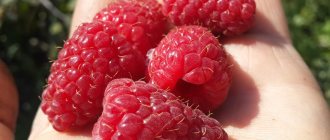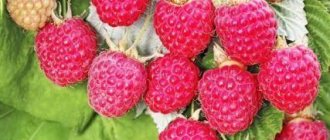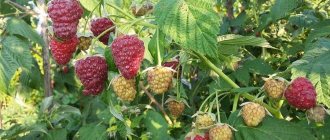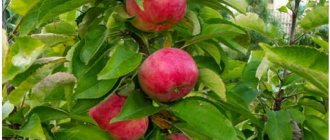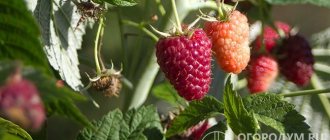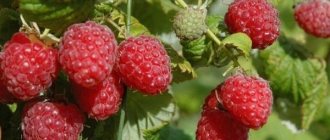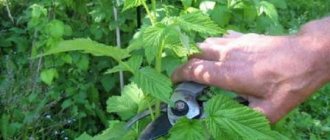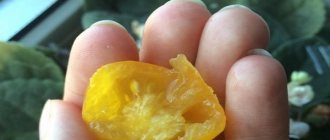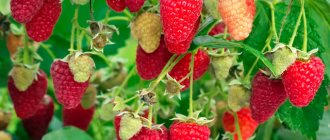Gardeners and gardeners happily grow raspberries on their plots. She has deservedly become the favorite of many. Today there are a huge number of varieties of this delicious berry. Among them you can find early and late ripening varieties, large-fruited and traditional. They all have their own advantages, but are practically the same in appearance. In this article we will learn about a variety that distinguishes itself from others due to its color. Raspberries “Golden Autumn” have received many positive reviews from gardeners who have already grown them on their plots. Therefore, it is worth considering the description of the raspberry variety “Golden Autumn”.
History of selection
Golden Autumn is a raspberry of Russian selection. At the beginning of this century, this elite variety was obtained by employees of the Kokinsky stronghold of the All-Russian Selection and Technological Institute of Horticulture and Nursery Growing (Bryansk Region) through free pollination of the selected form 13-39-11. The work was led by famous domestic scientists Ivan Kazakov and Sergei Evdokimenko, and for the latter, raspberry cultivation is the main area of specialization.
In 2001, the sample was given its own number 24-129-2, and three years later it began to be purposefully bred as an independent variety. Golden Autumn was included in the state register of breeding achievements in 2008 and recommended for gardening (not industrial) cultivation throughout the Russian Federation.
Did you know? Yellow raspberries first began to be cultivated in the 20s of the last century and initially gained a very dubious reputation: its fruits were small, crumbled and broke. However, in terms of frost resistance, these varieties always outperformed the red ones, and when American and English breeders managed to develop several elite yellow-fruited varieties, attitudes towards them changed dramatically.
In the little over a decade that has passed since the appearance of the new variety on the market, it has managed to win many fans, although it is cultivated mainly in the central and southern regions of Russia (Belgorod, Bryansk, Vladimir, Voronezh, Ivanovo, Kaluga, Kursk, Lipetsk, Moscow, Oryol , Ryazan, Smolensk, Rostov, Tambov, Tula), Dagestan, Adygea, Ingushetia, Kabardino-Balkaria, Alania, Chechnya, Stavropol and Krasnodar Territories.
In addition, Golden Autumn has been perfectly adapted in some countries near and far abroad, in particular in Belarus, Lithuania, Latvia, Estonia and Ukraine. The warm climate of Crimea is also excellent for growing raspberries and allows you to get a very good harvest from each bush.
Description and characteristics
The description of the variety should start with the bush. In Golden Autumn it does not grow too tall - only up to 1.5–1.6 m and has from 5 to 7 shoots of medium thickness. In the first year of life they are green and, in the absence of a garter, often bend towards the ground, but already in the next year they become lignified and become erect. The fruiting part of each shoot occupies more than half of its length. The thorns are located at the base of the branches, and their number is small. In the lower part of the bush the branching of the branches is high, but in general the plant is not too spreading and quite compact . The leaves have a bright emerald color; their characteristic feature is also pronounced wrinkling.
Did you know? In terms of its chemical composition, red raspberries compare favorably with yellow ones; our rare black and purple berries are considered even more useful. The first (black) were bred by the Americans, the second (purple) were obtained in Switzerland by crossing varieties with red and black fruits.
The berries have a slight pubescence, an elongated cone-shaped shape and a beautiful golden color, justifying the name of the variety. The taste of the fruit is dessert, but in addition to the usual sweetness there is added a slight sourness, characteristic of yellow raspberries and explained by the presence of more vitamin C in the fruits (compared to red berries). The drupes are small, and when biting they are almost not felt, so children eat raspberries with pleasure . The pleasant and balanced taste is also complemented by the exquisite aroma that Golden Autumn raspberries possess. But in general, the tasting rating of the berries is not very high: due to the presence of sour notes in the taste, on a five-point scale the fruits are rated only 3.9 points.
This variety cannot be called large-fruited either. The average weight of one berry is 4.5–5 g. With proper rationing (removal of excess ovaries) and good agricultural technology, larger fruits, up to 7 g, can be found on the bush, but such specimens are still rare.
Due to the dense structure of the berry, the raspberry variety in question is distinguished by its ability to hold well on the branch and not lose shape when picked . This circumstance makes the berries suitable for storage and transportation, and also determines their universal use: Golden Autumn raspberries are equally well suited for fresh consumption, canning and freezing whole.
Medium-ripening varieties of remontant raspberries
Raspberries in the garden can bear fruit throughout the season if you plant bushes of different ripening periods. The most popular and high-quality varieties of medium-ripening remontant raspberries are described below.
Antlant
Raspberries of the Atlant variety are a large-fruited variety. The berries of this type reach 6-10 g, are dense and transportable. They are easy to remove from the stalk.
The shoots of Atlant variety bushes are straight-growing, most of their length is fruitful.
You can remove 2-2.5 kg of berries from one bush. They begin to ripen in the second ten days of August. The taste of the berries is sweet and sour, juicy and delicate; they have an elongated conical shape. They can be frozen, processed and consumed fresh. The quality of the berries is very high.
Orange miracle
Raspberry variety Orange Miracle is a disease-resistant, productive, large-fruited raspberry variety. Its berries have an elongated conical shape, are 4 cm long, and reach 12 g in weight. The bright orange berries taste sweet and sour. The bush bears fruit until frost.
Cumberland
The Cumberland variety has an unusual appearance. This is a black raspberry bred in America. Thanks to her appearance, she attracts attention to herself. Small berries are covered with a waxy coating. They have a sweet taste similar to mulberry.
Did you know? Cumberland has beneficial properties: high content of vitamin C, antioxidants; consumption of berries stimulates the immune system and has antimicrobial and antiviral effects.
Cumberland berries have quite a lot of seeds, which many people don't like. The fruits are easily removed from the bush, can withstand a long shelf life, and are suitable for transportation. The fruits are well suited for making jam, freezing, baking, and cooking compotes.
If you provide proper care, the variety produces a yield of 10 kg per bush.
Polana
The remontant variety Polana is fast-growing and high-yielding. It is considered industrial, although it is found in ordinary household plots.
Polana is an old Polish raspberry variety. It is popular due to its simple agricultural technology.
The variety bears fruit from mid-August to November. The berries are located on the upper part of the shoots from the middle to the top. The shoots are 1.5 m high and grow without garter. The yield per bush reaches 6 kg.
The color of the berries is bright red, the surface is shiny. The weight of one berry reaches 3 g.
Himbo Top
The Himbo Top variety was bred by a Swiss breeder. This variety has fairly large berries, 6-8 g each. The berries are medium dense, easily removed from the stalk, and do not shrink until the end of the season.
The Himbo Topa harvest ripens in the 2nd half of August and can be harvested within 6-8 weeks, if the weather conditions of the growing area allow. One plant can produce a harvest of 3 kg.
Plants of this variety are demanding on soil fertility. The row spacing should be 2.5-3 meters, since the bushes form long lateral fruiting branches.
Ruby necklace
A productive variety - Ruby Necklace, has dense large berries of a bright ruby color. Their weight reaches no more than 8 g, the taste is sweet and sour, refreshing. At the bottom of the shoots there are thorns that do not greatly interfere with harvesting.
Yaroslavna
Many gardeners believe that Yaroslavna raspberries are one of the most delicious varieties of remontant raspberries. Also known under the names Brusvyana yellow and Rosyanitsa.
This mid-season variety bears fruits up to 3.5 cm in size. The color of the berries is yellow. From one bush you can harvest 4 kg of crop. Yaroslavna bushes grow up to 1.7 m, their branching is insignificant.
The Yaroslavna variety gives the first harvest in early June, the second - from August 10 to the end of October.
One of the disadvantages of the variety is low transportability, since the berries are soft, tender and have an average density.
Advantages and disadvantages
- Gardeners managed to appreciate Golden Autumn thanks to the following advantages of the variety:
- beautiful appearance, regular shape and bright color of the fruit;
- rich vitamin composition of berries (high content of ascorbic acid);
- lack of tendency to fall from the bush and scatter into segments during harvesting;
- long fruiting period;
- ability to adapt to different climatic conditions, large zoning area;
- excellent transportability and keeping quality of berries;
- universal purpose of fruits.
- Among the disadvantages of the raspberry variety in question are usually noted:
- the berries are not large enough;
- relatively low tasting scores of fruits;
- mediocre yield indicators;
- average frost resistance;
- lack of drought resistance;
- rather weak immunity to diseases and pests.
Drought resistance, frost resistance
Golden Autumn reacts to drought with a sharp decrease in yield, so abundant and proper watering is a prerequisite for cultivating the variety.
This raspberry is also not distinguished by increased . Even with good agricultural technology and proper preparation for winter, the critical temperature for the root system and fruit shoots is below -22°C. The bush can tolerate more severe weather conditions (temperature drops to -30°C), but only if such a cold spell does not last long and is not accompanied by sharp transitions from severe frost to thaw.
Important! In the context of a personal garden, the advantages of Golden Autumn compensate for all the disadvantages associated with its cultivation, but professional farmers still recognize the cultivation of this variety as unprofitable.
Productivity and fruiting
Golden Autumn is a classic example of a remontant raspberry . The bush enters the fruiting phase at the end of June or July (depending on climatic conditions), then after a short break, by mid-August or early September, the plant begins a second wave of fruit set, which, under favorable conditions, can continue until late autumn.
Like all remontant varieties, Golden Autumn does not have record yields. But good care allows you to remove an average of 2 to 2.5 kg of berries from one plant.
Video: Raspberry variety Golden Autumn
Varieties of early ripening remontant raspberries
Remontant raspberries have different ripening periods. There are different varieties of early remontant raspberries, some of which are very popular among gardeners.
Arbat
The Arbat variety of early-ripening remontant raspberry was obtained by Russian breeders. Its distinctive feature is very large berries weighing 15-18 g. There are quite a lot of them on a tall, powerful, straight-growing bush without thorns.
From one bush you can harvest 5-6 kg. You can harvest twice as much if you apply manure and care for the raspberry bushes.
The berries are elongated, conical in shape. Arbat is a red raspberry, its surface is shiny. The berries are easily removed from the stalk, without breaking. Raspberry Arbat has a sweet spicy taste and few seeds. Dense berries tolerate transportation well.
The variety's winter hardiness is average, and its resistance to diseases and pests is high.
Diamond
The Brilliant raspberry variety bears fruit abundantly; the bush reaches a height of 1.5 meters. The plant's thorns are soft and located at the base of the plant. The fruiting zone is half the stem. Conical large berries weighing up to 7 g ripen in the first ten days of August. They have a rich ruby color and a glossy surface. The taste is sweet and sour, dessert.
Brusvyana
Brusvyana is a remontant raspberry variety, the tree-like bushes of which are famous for their height - they reach 2 m. Brusvyana shrubs are very branched and have few thorns. The shoots of the bushes stand straight, which is convenient when harvesting. The shoot bears fruit throughout its entire height.
The berries of the Brusvyana variety are very large - 15 g. Their color is raspberry, the taste is sweet and sour.
Important! Brusvyana produces two harvests per year. The first harvest appears in mid-June, the second in August-September. The Brusvyana raspberry bush can produce a harvest of 7 kg
This variety is very popular and is therefore often used for commercial purposes. Has good transportability
The Brusvyana raspberry bush can produce a harvest of 7 kg. This variety is very popular and is therefore often used for commercial purposes. Has good transportability.
Bryansk miracle
The Bryansk miracle raspberry begins to bear fruit in the 2nd half of August. Fruiting continues until frost. During this time, the plant produces its entire harvest, which averages 3.5 kg per bush. The berries of Bryansk Diva have an average size of 5-7 g. The density of the berries is comparable to industrial varieties, the fruits can be stored for a long time, and they tolerate transportation well.
The taste of the berries of the Bryanskoye Divo variety is sweet and sour. The shape is elongated, especially pronounced in large specimens. The bushes of the plant do not need to be tied up if there is no threat of winds or rainfall. The branches do not have thorns, the bush itself is slightly spreading with thick shoots.
Bryansk miracle is a promising variety. If planted in an open sunny place, it allows you to get an early harvest of quality berries.
Hercules
Raspberry variety Hercules is a large-fruited, disease- and pest-resistant variety of remontant raspberry. This early variety has straight-growing shoots that do not need to be tied up or supported.
Half the length of the shoots is the fruiting zone. The thorns of the bush are thin, hard and prickly. The berries have a deep ruby color, their shape is truncated-conical. The weight reaches 10 g, and they taste sweet and sour.
The harvest from Hercules can be harvested from the beginning of August until the first frost.
Golden domes
Golden Domes is a high-yielding remontant raspberry variety. Gives 2 harvests per season. The first appears in late June - early July, the second - in August, and can be collected before frost. One bush can produce about 2 kg of harvest.
Bushes of the Golden Domes variety have an average height of 1.3-1.5 m. They are spreading, the shoots are drooping and practically without thorns. The berries of the variety weigh up to 6 g, their shape is round-conical, and their color is bright yellow. The berries of this variety taste like dessert, sweet and sour with a subtle raspberry aroma.
Lyashka
Polish raspberry variety Lyashka - early ripening. This is one of the most productive varieties with large berries.
The plant bears fruit for a long time. In mid-June the first harvest occurs, which lasts from 3 weeks. This variety is good for both home and industrial cultivation.
The berries of the Lyashka variety are red, elongated, large and slightly pubescent. The weight of the berries is on average 6 g, size 4 cm. Transportability is very good.
Shrubs of the Lyashka variety grow up to 2-3 m in height. The thorns on them are not aggressive, the stems are numerous and tough.
Perseus
The early summer raspberry variety Perseus has tall, erect shoots. Its berries can be medium and large in size, 3.1-5 g, and their color is dark red. The berries are easy to separate from the stalk and taste sweet and sour.
Perseus variety – ripening at the same time. The berries ripen in the 2nd half of June.
Landing Features
Agrotechnical rules for planting Golden Autumn raspberries can be called standard, but some features must be taken into account based on the climatic zone within which it is planned to grow the fruit subshrub.
Deadlines
There are two options for planting raspberries - in early spring and in the second half of autumn. The bush will overwinter much easier and then grow faster if it is planted in the fall, but this rule only works if the climatic conditions do not imply harsh and snowless winters with sharp temperature fluctuations. Therefore, traditionally in the southern regions and the middle zone it is better to plant raspberries in the fall , and for areas with a colder climate, spring planting is used.
Learn about the features of autumn planting raspberries.
When choosing specific calendar dates within a season, you should be guided by two standard rules:
- In spring, fruit bushes are planted in such a way that the buds begin to bloom after the plant is in the ground.
- In autumn , on the contrary, it is advisable to wait until the bush loses its leaves, otherwise the young shoots that begin to develop after planting will freeze in winter, and this negatively affects the overall winter hardiness of the plant. On the other hand, it is also impossible to be late with planting: the root system of the seedling must have enough time to establish itself in a new place. The best option is to guess the moment when there are about 3 weeks left before the first real frost.
Choosing a suitable location
One of the main secrets of a successful raspberry plant is the correct choice of place for planting it. Here it is important to comply with several requirements:
| Lighting | Maximum and uniform (rows are best placed from south to north) |
| Optimal groundwater depth | 1.5 m (if this parameter is less than 1 m, good drainage or a water drainage system is required) |
| Openness of the site | Raspberries are afraid of strong gusts of wind, so the area should be well protected, but air stagnation is also not allowed |
| Height and levelness of the site | The lowland is not suitable for shrubs due to the accumulation of cold air masses here, especially in winter, but at higher elevations the risk of the area being blown by the wind increases. The slope is allowed, but it must be gentle and, if possible, north |
| The soil | Light, fertile, with a neutral or acidic reaction. Sandstone, sandstone or chernozem are well suited. Clay, sand and limestone, as well as waterlogged soil are excluded |
| Good neighbors | Onions, garlic, peonies, marigolds |
| Bad neighbors | Tall trees, strawberries, strawberries, blackberries, meadowsweet |
| Good predecessors | Legumes, pumpkin |
| Bad Predecessors | Nightshades, strawberries, wild strawberries, sunflowers |
Selection and preparation of planting material
When choosing a seedling of a fruit tree or shrub, it is important to follow two fundamental rules:
- The seller must be trusted and have a good reputation (the best option is a professional gardening nursery).
- The place where the seedling was grown should be geographically as close as possible to the point of permanent location of the bush (transplantation).
Even Golden Autumn, which is not highly winter-hardy and drought-resistant, will take root much more easily in an extremely hot or, on the contrary, quite cold climate , if it was originally grown in these conditions. At the same time, a seedling brought from afar to a more favorable region has much less chance of successful development.
The selection technology is simple: the seedling must look absolutely healthy and have no visible damage. The presence of leaves on a young bush is not welcome - through it the plant loses a lot of liquid, which means it may be weakened
Golden Autumn, like all remontant raspberry varieties, can be planted at the age of one or two years. In the first case, the bush consists of 1 or 2 green shoots 30–40 cm high. A two-year-old seedling can have the same height, but its shoots are lignified and thicker (7–8 mm), and the root system is quite well developed. In both the first and second cases, a sign of good viability of a bush is the presence at its base (where the root meets the trunk) of at least one, or preferably several, powerful green buds . It is from these that young fruit shoots will subsequently begin to form.
Also find out how to transplant raspberries to a new place in the spring.
Landing algorithm
The technology for planting Golden Autumn raspberries is traditional and does not depend on the season or the age of the seedling. The algorithm looks like this:
- Dig a hole measuring 45x45x45 cm. The given parameters are approximate and can be adjusted depending on the size of the root system of the seedling, as well as the initial state of the soil (the less suitable it is for growing raspberries and the more it needs improvement, the deeper and more voluminous the planting hole should be) .
- Divide the soil removed from the pit into two parts: the top layer will be used in the future, the bottom layer is removed as infertile.
- Thoroughly mix the prepared part of the fertile soil with organic fertilizer, for example, humus or compost - about 10 kg of such organic matter will be needed per bush.
- Add to the resulting mixture mineral fertilizers containing potassium and phosphorus, for example, 100 g of superphosphate and 50 g of potassium sulfate (wood ash can be used as potassium fertilizer, but its amount must be increased to approximately 400 g).
- Return a small part of the nutrient soil mixture to the bottom of the hole and rake it towards its center in the form of a mound.
- Place the seedling on the surface of the formed hill and carefully spread its roots along the slopes.
- Fill the hole with the remaining soil, compacting it thoroughly.
- Form low sides of soil around the circumference of the trunk area and water the bush generously.
- When the water is absorbed, mulch the soil around the plant with peat, sawdust or coniferous “substrate” (rotten needles mixed with sand, which can be collected in a coniferous forest).
When planting several bushes, the standard distance between them should be maintained - at least 40 cm should separate one plant from another in a row, and if there is more than one row, you need to ensure a minimum row spacing of 1.5 m
Trimming
A distinctive feature of remontant raspberry varieties is the ability to produce a bountiful autumn harvest on annual shoots. To make the most of this opportunity, it is necessary to carry out autumn pruning of bushes completely to zero. It is best to prune remontant Golden Autumn raspberries in late autumn, before the onset of cold weather.
After harvesting the raspberries, all the nutrients from the shoots will have time to saturate the root system, which will have a positive effect on next year’s harvest. There is no need to leave stumps; the shoots are cut out at the root and the plantings must be mulched with straw, hay, and dry leaves. In spring, young shoots must be checked and the weakest and damaged ones removed so that the plant does not waste energy in vain.
Care
Golden autumn requires the same care as any remontant raspberry. Amendments should be made only for the low drought resistance of the variety and its lack of pronounced immunity against diseases and pests.
In order for the bushes to develop well and bear fruit, during the growing season it is necessary to ensure the following agrotechnical measures:
- Watering. Raspberries need to be watered infrequently, but abundantly. The plant makes maximum demands on moisture during the period of active growth of green mass (April - May) and flowering (June and then August). At the moment when the bushes are filled with berries, the intensity of watering must be reduced, otherwise the fruits may begin to rot.
- Loosening the soil. The procedure is necessary to retain moisture in the soil and prevent the formation of a dense crust that prevents the penetration of oxygen to the roots. When using drip irrigation, there is no need to loosen the soil, since in this case the water enters the ground in doses, without forming puddles, and therefore the top layer of soil remains fluffy.
- Weeding. Weed control is very important because they compete with the fruit bush for nutrients in the soil and, in addition, are reservoirs of various infections. You can solve the problem once and for the whole season by mulching, covering the soil around the bushes with a thick layer of peat, sawdust, straw or freshly cut grass.
- Trimming. Remontant raspberries need to be pruned in autumn and spring, leaving only the strongest and youngest shoots.
- Feeding. Remontant varieties need more fertilizer than ordinary ones, but you still cannot overdo it with these procedures. In the spring, raspberries are fed with urea, ammonium nitrate or other preparations containing nitrogen, and in the summer the emphasis is on phosphorus and calcium. To increase the yield in the fruiting phase, it is useful to spray the bush with boric acid (10–20 g per 10 liters of water); in the fall, the raspberry tree is enriched with organic matter (1 kg of humus or compost per bush), as well as potassium and phosphorus fertilizers (superphosphate, potassium sulfate etc.).
Harvesting and storage
The dense berries of Golden Autumn have good shelf life, but to increase shelf life, the crop must be harvested in dry weather and not washed until consumed. In this case, raspberries can remain in the refrigerator for up to 15–20 days, almost without losing their freshness . However, if the crop is planned to be processed, it is advisable to do this as soon as possible after harvest, since each day the fruit is stored reduces its nutritional value and increases the amount of waste.
Beautiful and well-shaped Golden Autumn berries are great for freezing, so if the housewife doesn’t have time to prepare compotes and jams, they can be prepared for the whole winter in literally a matter of minutes.
Read more about how to properly freeze raspberries.
Absolutely dry berries should be frozen; after washing, it is almost impossible to dry raspberries while maintaining their original appearance. Therefore, for this type of preparation, it is better to select the cleanest fruits hanging on the upper branches, which can be consumed unwashed.
In addition to traditional harvesting methods, you can make excellent wines and liqueurs from raspberries. Experts argue about the suitability of white varieties for these purposes, but among winemakers there are those who consider such drinks to be a very worthy alternative to classic white wine. In addition, raspberries blend well with other berries, such as currants, gooseberries or cherries.
Preparing for winter
The low frost resistance of Golden Autumn necessitates careful preparation of the bush for winter. These activities include:
- removing all leaves from each shoot (moving from bottom to top so as not to damage the fruit buds);
- cleaning the soil within the raspberry patch from all remaining organic matter (fallen berries, leaves, weeds), which is a traditional wintering place for pests;
- pruning all fruit-bearing two-year-old shoots (annual shoots of remontant varieties are not pruned, since they will bear berries next season), as well as damaged, diseased and weak branches;
- abundant watering of the bush to prevent the soil from freezing (water consumption should be one and a half times higher than the usual rate) - in dry soil, the root system tolerates frost more difficult;
- bending all the shoots remaining after pruning to the ground and attaching them with pins.
Important! Raspberries will survive the winter much easier if not only its root system, but also the above-ground part with fruit buds are under snow cover.
If the climate in the region where Golden Autumn is cultivated involves winters with a lot of snow, the gardener will need to provide the highest possible snowdrifts around each bush after the first snowfall. Ideally, the snow should completely cover the branches bent to the ground . In the case of short thaws, it is also important to ensure that an ice crust does not form on the surface of the snowdrift (the ice in this situation must be broken, otherwise the plant will rot from the lack of oxygen).
But if there is a risk of little or no snow in the winter, the raspberry tree needs to be covered in the fall. After the first frosts, which the bush must survive uncovered for hardening, burlap, agricultural fiber (spunbond) or other air-permeable material should be laid over the shoots bent to the ground , and it is fundamentally important that it be light.
We recommend that you learn more about how to prepare remontant raspberries for winter.
The edges of the bedspread can be secured with pins or any oppression, and on top, if desired (depending on how severe the winters are in the area), lay a layer of organic matter, for example, fallen leaves. Such a shelter must be removed at the beginning of spring , before the “living creatures” hibernating in the foliage (fungal mycelia, pest larvae, etc.) awaken from hibernation.
Peat, sawdust or pine spruce branches can also be used as a covering material. In this case, they can be laid directly on the shoots, without an additional layer
Reproduction methods
Raspberries grow very quickly without outside help, sending out numerous root shoots. Therefore, when planting bushes, they need to be carefully fenced, digging a fence to a depth of at least 50 cm, otherwise after a few years the gardener will face the real problem of the bush taking over an area not intended for it. On the other hand, these root shoots are excellent for propagating raspberries .
Did you know? From a botanical point of view, raspberries are not a berry. Moreover, this is not even a fruit, but several dozen fruits firmly fused together, each of which contains its own seed - the so-called polydrupe.
Thanks to the shallow root system that the bush has, the shoot is very easily dug out of the ground, after which it can simply be transplanted to a new location using standard technology for planting raspberry seedlings. This can be done throughout the growing season , but it is better to choose a time that is not the hottest and driest, so that it is easier for the young plant to take root.
Another way to propagate raspberries is by dividing the bush . This method is a little more difficult to implement, but when working with elite varieties, which include Golden Autumn, it is used quite often, since the number of root suckers in such raspberries is not so large. An adult plant is carefully dug up and divided with a sharp knife, starting from the root, into 4–5 parts, after which each of them is planted in a separate hole.
Finally, the most labor-intensive method of propagating a bush is cuttings . In this case, shoots obtained as a result of pruning are used as planting material. They are soaked in a growth stimulator, planted in a peat mixture and covered with film, and after the plant takes root, they are transplanted to a permanent place.
Seed propagation of raspberries in relation to the Golden Autumn should not be considered . Besides the fact that this is too troublesome, bushes grown from seeds do not retain the properties of the parent plant. For this reason, elite varieties cannot be reproduced using this method.
Planting and growing raspberries Golden Autumn
Healthy young shoots of one year of age can produce quick harvests if they have a developed root complex and a good emerald color of the stem. Even healthy seedlings are best planted in a well-lit place on the south side, surrounded by a fence or front garden. Drafts and shaded areas are contraindicated for raspberries.
It is good if the soil for the planting site is prepared in advance. The soil must not only be dug up, but also all weeds must be removed and nutrients added. From fertilizers, you can choose rotted manure or mineral components. For acidic soils, it is advisable to add fluff lime 200 grams per 1 square meter. For the same area you will need about a bucket of organic fertilizers, and about 300 grams of mineral fertilizers.
The soil for Golden Autumn raspberries is preferably neutral, fertile, with a light structure that quickly absorbs fertilizers and fertilizing.
Various growing methods are suitable for Golden Autumn raspberries. When choosing the trench method, it is advisable to maintain a distance of one meter between the rows, and at least 50 cm between the bushes. It is better to root the bushes to the line of the root collar, lowering the roots into the prepared holes. If the trench method is chosen, then it is enough to sprinkle the recesses with earth and lightly compact them. New plantings need to be thoroughly watered at the rate of about half a bucket per bush. The soil near the seedlings should be mulched with peat.
Diseases and pests
The low immunity of Golden Autumn to diseases and pests requires the gardener to pay special attention to the issue of preventive treatment of bushes. The procedure should be started in early spring, before the buds have yet opened, and then before the fruit begins to set, carry out another 2-3 sprayings.
Important! During flowering, raspberries cannot be treated with pesticides, so preventive procedures should be carried out before flowering begins or postponed until its completion.
When choosing a drug for treatment, care should be taken to ensure that it has a fungicidal (antifungal), insecticidal (pest control) and acaricidal (against ticks) effect, since Golden Autumn can be attacked by all three types of pathogens. Some modern products (for example, “Brunka”, “Oleokuprit”, “Sulfarin”, etc.) make it possible to provide comprehensive protection to the bush, although drugs with a narrower focus are more common.
Examples include:
| Fungicidal preparations for raspberries | Insecticidal preparations for raspberries | Anti-tick medications |
|
|
|
Golden autumn - raspberries, which, with good care, can become the real queen of a summer cottage. This variety is not distinguished by either a large harvest or large berries, but it bears fruit from mid-summer and, after a short break, almost until frost. The fruits store well and can be used in any form, including frozen. But still, for summer residents who rarely visit their garden plots, Golden Autumn is not suitable: the variety is quite demanding to care for, needs regular watering, fertilizing, as well as preventive treatments against diseases and pests.
Reviews
Ekaterina N : I bought seedlings at a gardening fair (the seller really praised the variety to me) and was not disappointed. We have been enjoying delicious yellow berries for three years now. Last fall it was very cold and rainy, so everyone thought - we wouldn’t really eat berries, but no, our beauty delighted us until the frost. Definitely recommend!
Sergey S : For me, this is one of the best varieties of remontant raspberries. I planted it in a sunny place in the corner of the garden, where it is less windy, I fertilize it on a schedule, prune it, and from the end of summer until the first frost, the whole family harvests it.
